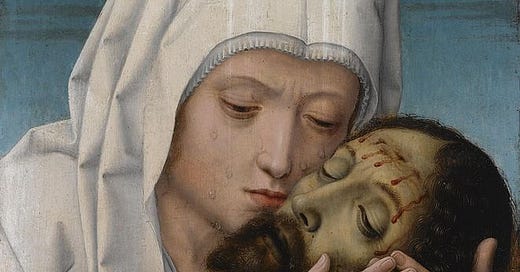The Extraordinary Passion of Mystical Love in Late Medieval Piety
A fourteenth-century text entitled A Talking of the Love of God shows us the emotional intensity of medieval spirituality.
My first post for Via Mediaevalis was a reflection on Caedmon’s Hymn, which is a simple but finely crafted expression of the elemental, wonder-filled spirituality that we find in the early Middle Ages. This was a time when northern Europe was in transition between paganism and Christianity, and many Christians were still breathing the pantheistic, animistic air of their ancestral religions. Even those who fully embraced Christian doctrines and practices might retain a deep, primal reverence for the powers of nature and the unsearchable mysteries of the heavens. To infuse this reverence with newfound belief in an all-knowing, almighty, compassionate God was to engender and nourish the sort of spirituality that we see in Caedmon’s first poem.
By the late Middle Ages, this spirituality had matured into something quite different. The word “matured” is chosen carefully here; I don’t want to give the impression that religious experience veered off in a new direction. What occurred was organic growth and coexistence, not rupture and replacement. Nevertheless, late medieval culture did give rise to expressions of Christian spirituality that are, in their passionate language and nuptial imagery, unlike anything written before or since.
A Talking of the Love of God appears to have been among the most popular English-language devotional works of the fourteenth century. It was composed in Middle English, which for modern folks is more comprehensible than Old English but often quite difficult, and sometimes extremely difficult, to read. (The title sounds strange to us because the author used an older Germanic word, “talking,” where we would use a newer word derived from Latin, such as “discourse” or “treatise.”) To give you an example of the treatise’s language, and of its arresting content, here are the first few sentences after the introduction:
All of the remaining quotations from A Talking are my translations from the Middle English. If they sound a bit strange it’s because I’m trying to retain some of the original’s mystique and intensity. Here is a rendering of the passage above:
Daniel McCann, a scholar in medieval literature at Oxford, has some fine commentary on this opening section:
The text really begins here with its central preoccupation: Jesus. This opening is compelling in its lyrical and meditative potency, as the constant repetition of the holy name and the careful use of alliteration generate a familiar and recursive pattern of sound and sense that is as hypnotic as it is rhetorically exuberant.... The cascade of repetition builds up an emotive charge, a breathless yearning.... Jesus is everywhere and everything, beyond yet also a part of creation.1
By the late Middle Ages, centuries of pervasive spirituality had culminated in an overpowering desire for union with God as the glorious wellspring of all that was good and beautiful and joyful in human life. Saints and mystics—some of them also authors who wrote for the spiritual edification of others—reached a state that can only be described as deep, passionate love for Jesus Christ, the image and incarnation of the invisible and intangible Deity.
A Talking of the Love of God, along with other works in this genre such as The Wooing of Our Lord, is written in rhythmical prose with much alliteration and occasional rhyme. The imagery is vivid, the meditations are emotionally charged, and some find that the lyrical expressions of love at times exhibit a degree of eroticism.
What are we to make of these “religious love-lyrics,” as they have been called? That’s not an easy question to answer, especially given the spiritual crisis that I discussed in my introduction to the Via Mediaevalis newsletter—modern man is struggling not only to practice spirituality but even to comprehend the vibrant, impassioned spirituality of ages past. Nevertheless, the core of the explanation is this: The authors of these works gradually attained to such overwhelming intimacy with God that ordinary modes of expression failed them. Only one form of language—the language of passionate love—could convey, though still imperfectly, the nature of their feelings and experiences.
The poetical prose of A Talking is filled with amorous thoughts directed to Christ. We don’t know with any certainty if it was written by a man or a woman, or if the intended readers were primarily male or female, but as with other mystical texts, the affection being expressed in the words of human passion is actually affection between the soul and God. Spiritual love resembles earthly love but also utterly transcends it.
The body of Christ in this text is a paradoxical object of simultaneous desire and horror—His beauty is captivating, but the wounds and desecrations of His Crucifixion are appalling. But in the gaze of the enamored soul, even His wounds are resolved into objects of desire, for they signify the agonies by which He proved His true and vehement love for mankind.
The author of A Talking longs to stay forever in motionless physical contact with Christ, singing to Him and drinking the life-giving blood from His wounded side. The text concludes with a beautiful image of two lovers in an everlasting embrace of blissful life and liberating death:
Daniel McCann, Soul-Health: Therapeutic Reading in Later Medieval England. University of Wales Press, 2018, p. 122.
















This so beautiful! Is there a complete writing one could refer to? Perhaps with original English with modern English side by side? I find myself very drawn to it. (As you can see, I'm reading your first posts to catch up with the current ones - such excellent material.)